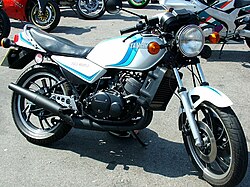Yamaha RD 350 LC
The Yamaha RD 350 LC is like the Yamaha RD250 LC a two-stroke motorcycle the Japanese motorcycle manufacturer Yamaha and appeared 1980th
The performance-optimized motorcycle has been significantly modernized compared to its air-cooled predecessor models, the Yamaha RD 250 and RD 350 . It is driven by a water-cooled two - stroke engine with two cylinders and separate lubrication . The rear wheel was guided by a cantilever arm with a central spring strut.
Due to the typical two-stroke power development of a high-revving engine, the RD 350 LC only suddenly started performing at a speed of approx. 6000 rpm, which many inexperienced drivers could not cope with and often caused accidents. In the 1981 model year, the manufacturer reduced the maximum output for the German market to 34 kW (46 hp) in favor of a flatter performance curve . In Austria the model was sold with 36 kW until 1983. For the German market, the RD 250 LC with 38 HP and the RD 350 LC with 46 HP could be throttled to 20 kW (27 HP ), which at the time was cheap for insurance, by means of reducing sleeves in the exhaust manifolds and changing the main carburettor jets. When the successor model Yamaha RD 350 YPVS appeared in 1983 , the RD 250 LC was discontinued on the German market without a successor model.
Strengths and weaknesses
The test reports of the trade press and the experiences of the owners showed some weaknesses after the market launch: The swing arm bearing of the rear wheel was mounted in plastic bushings that could be worn after a few thousand kilometers and caused the rear suspension to swing. The accessories trade then provided bronze bush bearings or a conversion to needle bearings. Engines that were not warmed up carefully could demand an engine overhaul (boring the cylinders to an excess) after around 20,000 kilometers. The consumption of the 350 model could be more than 10 liters of super per 100 kilometers with constant high-speed driving. The bores for the oil supply in both carburettors should be cleaned regularly. If the bore is dirty or gummy due to a long idle time, this inevitably leads to engine damage.
Technical specifications
| Surname | model | Construction period | power | Displacement | Front brake |
|---|---|---|---|---|---|
| RD 250 LC | 4L1 | 1980-1983 | 28 kW | 247 cc | disc |
| RD 350 LC | 4LO | 1980 (in Austria 1980 to 1983) | 36 kW | 347 cc | Double pane |
| RD 350 LC | 4LO | 1981–1983 (Germany) | 34 kW | 347 cc | Double pane |
| RD 350 LC YPVS | 31K | 1983-1985 | 43 kW | 347 cc | Double pane |
| RD 350 LC YPVS | 1WW | 1986-1989 | 46 kW | 347 cc | Double pane |
Web links
- Michael Pfeiffer: Final: Yamaha RD 350 YPVS. (Text) In: MOTORRAD online . March 26, 2009. Retrieved October 22, 2011 .

